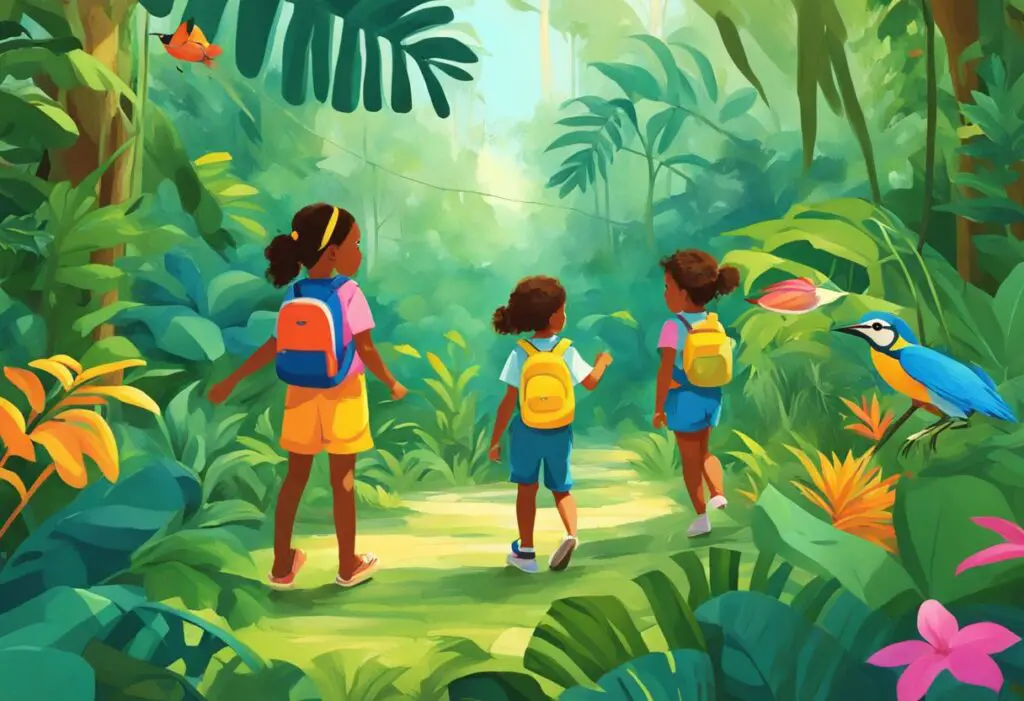Are you tired of hearing your child say, “I’m bored” or “There’s nothing to do”?
Do you wish your child had a sense of curiosity and exploration about the world around them? Well, you’re in luck! Instilling a sense of curiosity and exploration in your child is easier than you might think.

Curiosity is a natural human trait that drives us to explore, learn, and discover new things. It’s what makes us ask questions, seek answers, and try new experiences. By nurturing your child’s curiosity, you can help them develop a lifelong love of learning and exploration. From asking questions to trying new activities, there are many ways to foster curiosity in your child.
Exploration is another important aspect of childhood development. By encouraging your child to explore their environment, you can help them develop important skills like problem-solving, critical thinking, and creativity. Whether it’s exploring the outdoors, trying new foods, or experimenting with art or music, there are endless opportunities for your child to explore and discover new things. So, what are you waiting for? Let’s get curious and explore the world together!
Cultivating Curiosity in the Playroom
As a parent, you want your young children to be curious and eager to learn. One of the best ways to instill a sense of curiosity and exploration in your kids is through play. In fact, play is an essential part of a child’s development. It’s how they learn about the world around them and develop important skills like problem-solving, creativity, and socialization.
The Power of Play and Discovery
When it comes to play, the possibilities are endless. From building blocks to dress-up, there are so many activities that can spark your child’s curiosity and imagination. The key is to provide them with opportunities to explore and discover new things.
Encourage your child to try new things and take risks. Let them explore their environment and ask questions. When your child is playing, try not to interrupt or direct them too much. Instead, let them take the lead and see where their curiosity takes them.
Games and Exploratory Play
Games are another great way to encourage exploratory play. Board games, puzzles, and other games that require problem-solving and critical thinking can help your child develop important skills while having fun.
-

Bold Male Pride – Baseball Trucker Cap Celebrating Masculinity
£18.00 Select options This product has multiple variants. The options may be chosen on the product page -

Dad Bod Appreciation Gift Mug
£14.00 Add to cart -

Dad Bod, Bad Jokes Structured Baseball Cap
£22.00 Select options This product has multiple variants. The options may be chosen on the product page
When playing games with your child, try to focus on the process rather than the outcome. Instead of worrying about who wins or loses, focus on the skills your child is developing and the fun they’re having.
In addition to traditional games, there are also many games that are specifically designed to encourage exploratory play. These games often involve open-ended play and allow your child to use their imagination and creativity.
Overall, the key to cultivating curiosity in the playroom is to provide your child with opportunities to explore, discover, and learn. Encourage them to try new things, ask questions, and take risks. With a little bit of guidance and a lot of play, your child will be well on their way to becoming a curious and lifelong learner.
Unleashing Questions in the Wild

As a parent, you want your child to be curious and ask questions about the world around them. Encouraging your child to ask questions is an excellent way to nurture their inquisitive minds. Here are a few tips to help you unleash your child’s curiosity and encourage them to ask questions.
Encouraging the Why and How
Children are naturally curious, and they ask a lot of questions. As a parent, you need to encourage your child to ask questions and answer them in a way that satisfies their curiosity. It’s important to ask open-ended questions that encourage your child to think about the world around them. For example, instead of asking your child what color the sky is, ask them why they think the sky is blue. This will encourage them to think critically and come up with their own answers.
Nurturing Inquisitive Minds
Children are naturally curious, and they want to explore the world around them. As a parent, it’s important to encourage your child’s natural interests and let them explore the world at their own pace. Let your child ask questions about topics that interest them and answer them in a way that satisfies their curiosity. You can also take your child on nature walks or visit museums to help them explore the world around them.
Remember, asking questions is a natural part of learning, and it’s important to encourage your child to ask questions about the world around them. By nurturing your child’s natural curiosity, you can help them develop a love of learning that will last a lifetime. So, go ahead and unleash the questions in the wild, and watch your child’s inquisitive mind grow!
The Great Indoors: Fostering Exploration at Home
As a parent, you want your child to be curious, explore their surroundings, and learn new things. But how can you instill a sense of wonder and curiosity in your child? One way is to encourage exploration at home. With a little creativity, you can turn your home into a laboratory of learning and discovery.
DIY Science and the Kitchen Laboratory
Science isn’t just for the classroom. You can create a mini-laboratory in your kitchen with everyday items. For example, you can make a lava lamp with oil, water, and food coloring. Or, you can make a homemade volcano with vinegar and baking soda. These experiments are not only fun, but they also teach your child about chemical reactions and the scientific method.
Another fun experiment is to make slime. You can use glue, Borax, and food coloring to create a slimy, gooey substance that your child will love. Not only is it fun to play with, but it also teaches your child about polymers and chemical reactions.
Reading Adventures and Storytime Quests
Reading is a great way to foster curiosity and imagination in your child. You can create a reading adventure by turning your home into a magical world of wonder. For example, you can create a treasure hunt where your child has to read clues to find a hidden treasure. Or, you can create a storytime quest where your child has to read a book to unlock a secret code.
You can also encourage your child to create their own stories. Give them a prompt, such as “What if you could talk to animals?” or “What if you lived on the moon?” and let their imagination run wild. Not only does this encourage creativity, but it also helps your child develop their writing skills.
In conclusion, fostering curiosity and exploration in your child doesn’t have to be difficult. With a little creativity, you can turn your home into a laboratory of learning and discovery. By encouraging DIY science experiments and reading adventures, you can instill a sense of wonder and curiosity in your child that will last a lifetime.
The Role of Educators in the Quest for Knowledge
As an educator, you play a crucial role in instilling a sense of curiosity and exploration in children. Your classroom is a place where young minds can thrive and grow, and it is up to you to create an environment that encourages learning and discovery.
Classroom Strategies for Engagement
One of the most effective ways to promote curiosity in the classroom is through problem-solving and critical thinking. Encourage your students to ask questions and explore different solutions to problems. You can also use hands-on activities and experiments to engage your students and make learning more fun.
Another strategy is to incorporate games and other interactive activities into your lessons. This can help keep your students engaged and interested in the material, while also promoting teamwork and collaboration.
Pedagogy and Humor: Learning with Laughs
As an educator, you don’t have to be serious all the time. In fact, incorporating humor into your lessons can be a great way to engage your students and make learning more enjoyable.
For example, you can use jokes and puns to help your students remember important concepts or vocabulary words. You can also use funny stories or anecdotes to illustrate key points and make your lessons more memorable.
In addition to making learning more fun, humor can also help create a positive classroom environment. When your students feel relaxed and comfortable, they are more likely to be curious and engaged in the learning process.
Overall, as an educator, you have the power to inspire young minds and instill a lifelong love of learning. By using effective classroom strategies and incorporating humor into your lessons, you can help your students become curious, engaged, and enthusiastic learners.
Digital Discovery: Technology as a Portal
As a parent or educator, you may be hesitant to introduce technology to children. However, technology can be an excellent tool for instilling a sense of curiosity and exploration in kids. With the right approach, technology can encourage interactive learning and spark an interest in new information.
Interactive Learning with Technology
One way to use technology for interactive learning is through educational websites and apps. PBS Kids, for example, offers a range of games and activities that teach children about science, math, and more. These types of resources can provide a fun and engaging way for kids to learn new information.
Another way to encourage interactive learning is through virtual field trips. With technology, children can explore new places and learn about different cultures without ever leaving the classroom. This can be a great way to spark curiosity and encourage children to ask questions.
Screen Time and Curiosity: Striking a Balance
Of course, it’s important to strike a balance between screen time and other activities. Too much screen time can actually hinder a child’s curiosity and exploration. As a parent or educator, it’s important to monitor screen time and encourage children to engage in other activities, such as outdoor play or reading.
When introducing technology to children, it’s also important to keep novelty in mind. Children may quickly lose interest in a particular app or website if it becomes too familiar. As such, it’s important to regularly introduce new resources and activities to keep children engaged and curious.
In conclusion, technology can be a valuable tool for instilling a sense of curiosity and exploration in children. By using educational resources and virtual field trips, you can encourage interactive learning and spark an interest in new information. However, it’s important to strike a balance between screen time and other activities and to keep novelty in mind to maintain children’s interest.
The Science of Curiosity and Its Impact on Development
As a parent, you want your child to succeed in school and in life. You want them to have a “hungry mind” that is always seeking out new information and experiences. One way to instill this sense of curiosity and exploration is by understanding the science behind it.
Understanding the Curious Brain
Curiosity is not just a personality trait, it is a fundamental part of our brain development. When we encounter something new or unexpected, our brain releases dopamine, a neurotransmitter associated with pleasure and reward. This creates a positive feedback loop that encourages us to seek out more novel experiences.
For children, this means that fostering curiosity can have long-term benefits for their brain development. Research has shown that curious children have increased activity in the hippocampus, a part of the brain associated with memory and learning. This can translate to better academic achievement and success in school.
Long-Term Benefits of an Inquisitive Childhood
But the benefits of curiosity go beyond just academic success. Curious children are more likely to be creative, innovative, and adaptable. They are better able to problem-solve and think critically. They are also more resilient in the face of challenges and setbacks.
So how can you instill a sense of curiosity in your child? Start by encouraging exploration and discovery. Provide opportunities for your child to try new things and learn from their mistakes. Ask open-ended questions that encourage them to think creatively and critically. And most importantly, model curiosity yourself. Show your child that you are always learning and exploring new things, and they will be more likely to follow in your footsteps.
In conclusion, understanding the science of curiosity can help you foster a sense of exploration and discovery in your child. By encouraging curiosity, you can help your child develop a “hungry mind” that will serve them well throughout their life.







